No managerial departures in the Premier League this season; that has only happened twice before at this stage of a campaign over the past decade; five managers had been sacked at this stage last season; who’s under pressure, who’s available and does the manager bounce exist?
The average number of manager sackings before the end of November in the preceding five seasons has been more than three – 3.4 to be exact.
There were five sackings by this stage of the season in the previous two campaigns. Last season, Scott Parker (Bournemouth), Thomas Tuchel (Chelsea), Bruno Lage (Wolves), Steven Gerrard (Aston Villa) and Ralph Hasenhuttl (Southampton) had all received marching orders by the November international break.
So, why haven’t there been any managerial sackings so far this season?
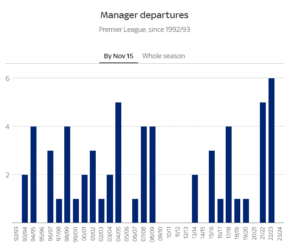
Teams are where they should be
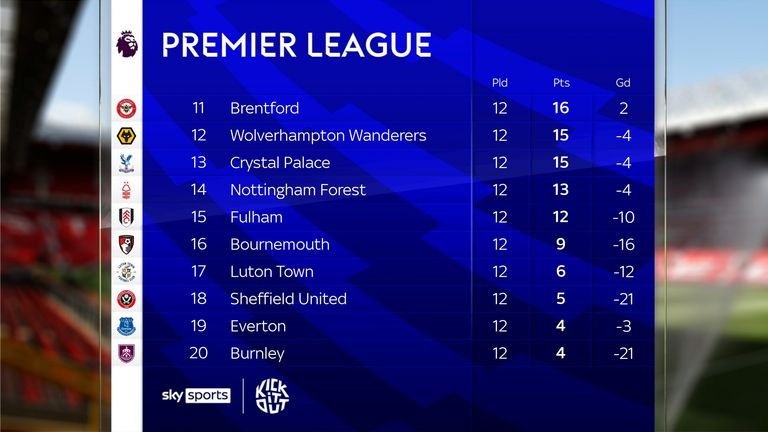
There is a strong argument that most clubs are more or less where they are expected to be in the table. There are very few obvious under-performers and the three newly-promoted teams sit in the bottom four – with Luton rising into 17th after Everton were deducted 10 points.
You could say that Burnley are doing more poorly than expected under Vincent Kompany, given how they stormed the Championship last season, but the Clarets have never had their football so good up there since his arrival. They really want it to work and might look at Kompany to be the ideal man to bring them back up if they go down.
Above them, 18th-placed Sheffield United have seen plenty of speculation about Paul Heckingbottom’s future – even rumours of a Chris Wilder return – but he is still in the job and they have picked up two good results against Wolves and Brighton. Why cut the green shoots of progress now?
And nobody is expecting fourth-bottom Luton to be anywhere other than they are; knowing it would be a miracle if they stayed up and this season being more about cementing the long-term future of the club.
Expected Premier League table
The xP table suggests the promoted clubs should be in the relegation zone, but all three should have collected more points than they have – with Burnley dropping more than four points so far this season.
Based on quality of chances in front of goal and conceded, the table below suggests Everton and Chelsea are the most underperforming teams this season, with Everton also suffering from a 10-point deduction.
Bournemouth have more obvious ambitions to stay up this time so it is no surprise the future of Andone Iraola has also been under the spotlight, given they are just three points above the bottom three. But again, two wins from their last three games shows more promise.
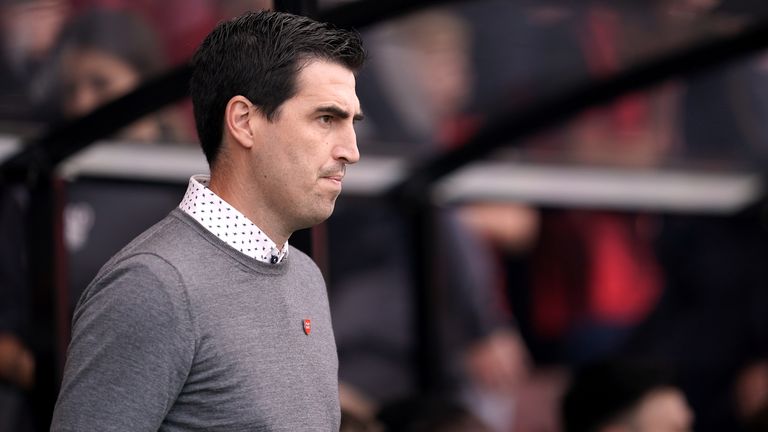
You could argue that Fulham should be doing better given their strong season last time but Marco Silva has just signed a new contract and they want to build the club around him.
The other teams are more or less where they should be, picking up results inconsistently, and – as for the top teams – only Chelsea you could say are still way below where they typically should be. But we know they at the beginning of process of development under new manager Mauricio Pochettino. So no changes on the horizon there by any means.
Who else is out there?

Has the clubs’ proclivity for changing managers so frequently reduced the pool of credible replacements? Are they running out of options?
For starters, you look at the managers that are currently out of work and struggle to see many obvious candidates that have already done a good job in the Premier League. There are only one or two for the top sides and a further few for the rest.
If you’re a big club you might look at Antonio Conte or Zinedine Zidane. Further down, Julen Lopetegui showed his credentials before falling out with Wolves, Graham Potter certainly deserves another chance at a good club, and Hansi Flick is available.
We are probably not yet at the stage of calling for a firefighter such as Sam Allardyce, but even that didn’t work for Leeds last season and he can’t keep being called upon in that fashion. Dean Smith is also available and is another good coach but he could not keep Leicester up either.
So bringing in another top-performing coach – at least currently – from elsewhere is the other option and that also brings with it its risks midway through a season. There are many examples of when it has worked but it seems like clubs have not reached panic stations yet just 12 games in.
Does axing manager in relegation zone boost survival chances?
Sky Sports’ Adam Smith:
Sky Sports scoured the archives to document every instance when a Premier League team has sacked a manager while in the relegation zone, according to positions listed on Transfermarkt, and the eventual outcome – to uncover whether it improves clubs’ chances of survival.
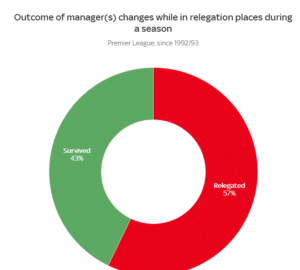
In total, only 33 of 77 clubs survived after axing their manager in the drop zone – which equates to 43 per cent. That means clubs still have a 57-per-cent chance of relegation after axing a manager midseason.
All figures only include the first managerial change while in the relegation zone during respective seasons.
Of course, there are several other factors to consider, such as the position of the club within the relegation zone and what period of the season the managerial change occurred.
Starting with position, unsurprisingly, clubs are far better off axing managers before they hit rock bottom. Since 1995/96, when the league was trimmed to 20 clubs, teams changing manager when sat in 18th have a survival rate of 54 per cent, while teams in 19th have a 57 per cent chance.
However, that ratio plummets to just 15 per cent for teams axing their manager when sat bottom of the table.
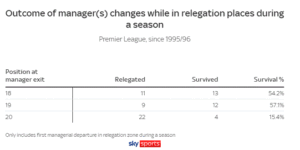
What about time period? Well, the same mantra appears here, too: strike early. The table below highlights how survival rates remain largely positive until the turn of the calendar year.
After this point, only three out of 24 clubs since 1992/93 have avoided the drop: Southampton (Ian Branfoot) in 1993/94, Aston Villa (Paul Lambert) in 2014/15 and Everton last season.
Clubs appear to know this, with the majority of changes occurring between October and December.
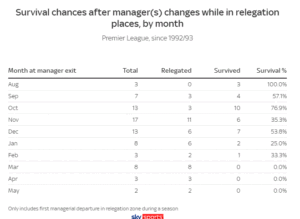
The chart below clearly visualises how the survival rate dips over the course of a season – with no club ever surviving after axing a manager while in the bottom three beyond the month of February.
The table below merges both position and time into one table since 1995/96 and emphasises the clear correlation between survival and axing a manager early while in 18th or 19th place. No club has retained top-flight status after sacking a manager while rock-bottom after the month of October.
Winners and losers?
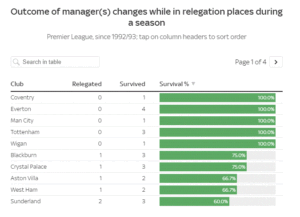
Tottenham achieved the biggest bounce in history after they sacked Juande Ramos in October 2008, hoisting from 20th to finish the season in eighth spot under Harry Redknapp.
In terms of clubs’ historic success with the manager bounce during precarious times, Nottingham Forest might think twice about relieving Cooper of his duties, having previously sacked Frank Clark in 1996/97 and Dave Bassett in 1998/99 while in the bottom three over the past 31 years – suffering relegation both times.
In contrast, Everton – who sacked Frank Lampard while sat 19th in the table in January – have now retained their unbroken top-flight status all four times after axing a manager while in the relegation zone.
In summary, the chances of avoiding the drop following a managerial change after the turn of the year stands at just 13 per cent – regardless of position. In addition to acting early, clubs should make managerial changes before hitting rock-bottom.

